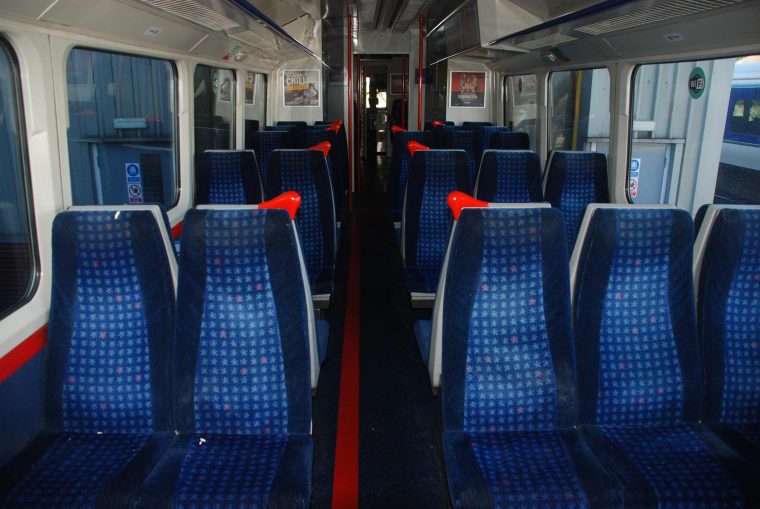www.magazine-industry-usa.com
30
'19
Written on Modified on
ANGEL TRAINS, DB ESG AND STRATASYS TRIAL THE UK’S FIRST 3D PRINTED PARTS ON PASSENGER TRAINS
With the ability to quickly produce replacement parts on-demand, 3D printing helps operators to better maintain trains and improve the quality of service for passengers

The cross-industry collaboration between Angel Trains, DB ESG and Stratasys aims to leverage 3D printing to help overcome issues around the replacement of obsolete parts across the UK rail industry. Unlike the automotive industry, where vehicles from household brands are mass produced in their millions each year, the number of fleets in the rail industry are comparatively very small and, in some cases, over 30 years old. This combination presents several challenges for train operators, especially when it comes to vehicle maintenance and part replacement.
“In recent times, we’ve seen growing concern amongst operators that sourcing replacement parts for older train fleets at a reasonable cost and in a short timeframe is proving increasingly difficult,” explains James Brown, Data and Performance Engineer, Angel Trains.
“The problem is that traditional manufacturing methods only make it cost-effective to produce high volumes of spare parts, even though an operator may only need a few obsolete train parts replaced. In addition, lead times can take months. This is why we have teamed up with DB ESG and Stratasys, showing how operators can overcome these hurdles by using 3D printing to produce the exact amount of parts they need at a fraction of the time and cost of traditional methods,” he adds.
Significant decrease in production cost and lead times
Such cost and time efficiencies are exemplified by the armrest feature currently in-service with Chiltern Railways. According to Brown, the lead time for this part using conventional manufacturing methods would be approximately four months. However, with Stratasys FDM 3D printing, the final armrest can be produced within one week, representing a decrease of almost 94%. Brown believes that savings of up to 50% per part will be achievable.
Similarly, in the case of the grab handle device, the replacement part was obsolete and the original supplier’s business was no longer in operation. As a result, to make more of these parts a new manufacturing tool would have been required, costing up to £15,000 and with a production lead time of two and a half months. With 3D printing, the seven grab handles required were produced at a significantly lower cost per part in three weeks.
“This is an exciting time for the UK rail industry,” continues Brown. “With this technology, train operators can be much more responsive to replacing passenger-facing parts that get damaged or vandalized. A 3D printed replacement part can be produced on-demand and installed immediately. With low-volume production now achievable, we’re also starting to explore how we can leverage 3D printing to customize interiors that are better suited to the passenger commute. For example, we’ve tested 3D printing seat back tables with braille informing the passenger that the toilet is ten rows back from that particular seat. This level of customization is unprecedented and can only be enabled by 3D printing, offering the potential to significantly improve both the servicing of trains and the passenger experience in the future.”
DB ESG conducted comprehensive testing on a range of industrial-grade 3D printing materials to ensure the first-ever compliance to UK rail industry standard EN45545-2 by 3D printed parts. The final parts were 3D printed using Stratasys’ FDM-based Fortus 450mc Production 3D Printer in ULTEM™ 9085 resin, which was certified to the rail industry’s fire, smoke and toxicity standards.
Martin Stevens, Mechanical Engineering Manager DB ESG comments: “Achieving certification removes a major barrier that has prevented more widespread implementation of 3D printing across UK trains. Our role in this project has been to investigate the design, production and finishing of FDM parts, verifying whether the parts comply with rail standards and checking whether they work in the operating environments. We have also optimised the component design of FDM manufacture.”
Phil Andrews, Interim Engineering Director at Chiltern Railways says: “At Chiltern Railways we are excited to be part of this innovative trial using 3D printed parts on our trains. 3D printing has a much quicker turnaround and is more cost-effective than traditional manufacturing methods. With much of our fleet approaching 30 years old, it’s vital that we can source the parts we need as quickly as possible. This trial will play a part in maintaining our industry-leading customer satisfaction scores and ensure our train interiors are maintained to the highest standards.”
Following the success of the trial to date, the group has now established a repeatable process that produces parts compliant with rail industry standards and suitable for use in passenger vehicles. With positive responses received from train operators, the three-way consortium is now set to commence its next trial with Great Western Railway, which plans to integrate 3D printed parts within a selection of trains over the next few months.
Yann Rageul, Head of Strategic Accounts for EMEA at Stratasys, concludes: “Having successfully proven the viability of 3D printed parts within trains in the UK, the impact on the traditional rail industry supply chain can be transformative. Train operators can eradicate the issues associated with physical inventories by building a library of digital inventory that can be 3D printed as and when they need it, wherever they need and in the exact quantity required. We are witnessing a new era of true on-demand production with no waste.”
www.startasys.com

